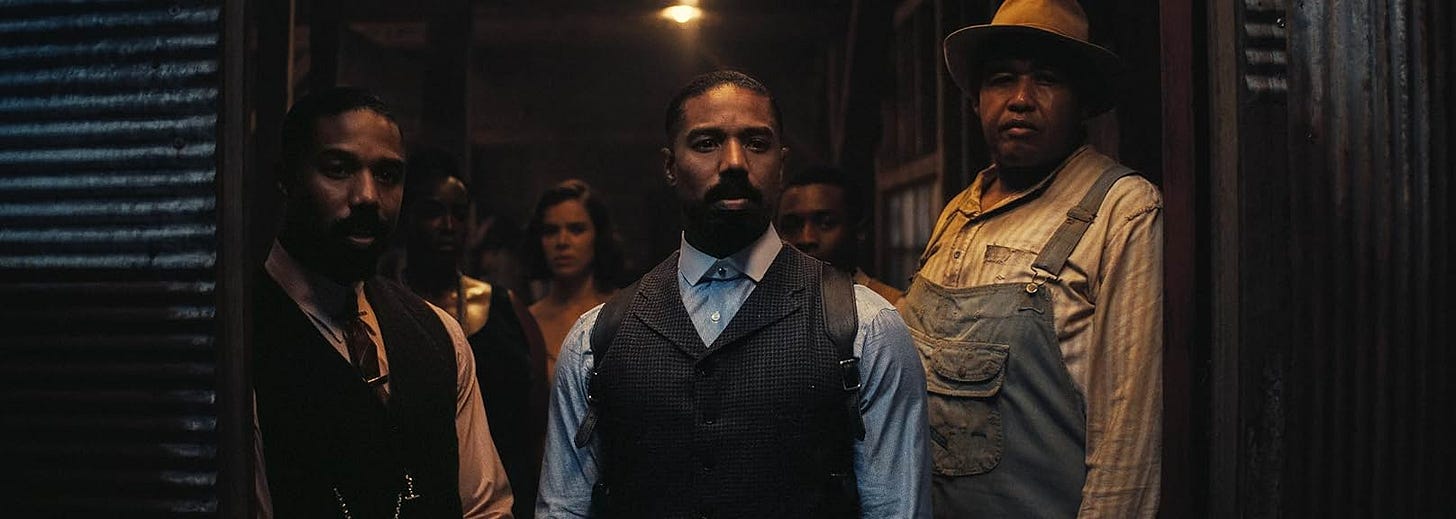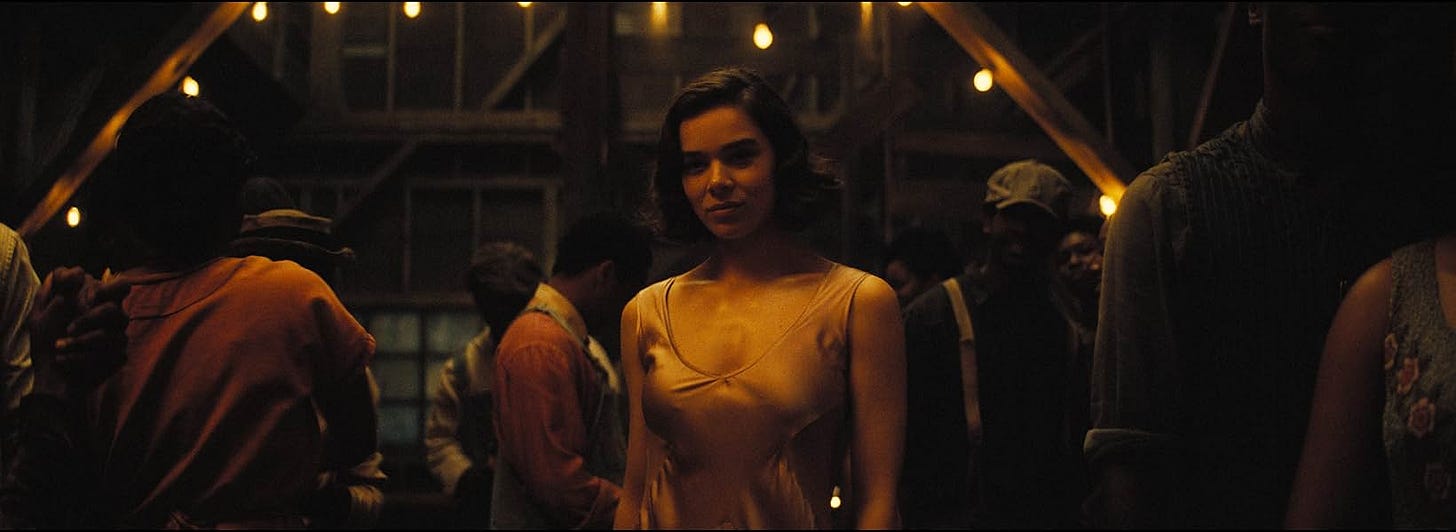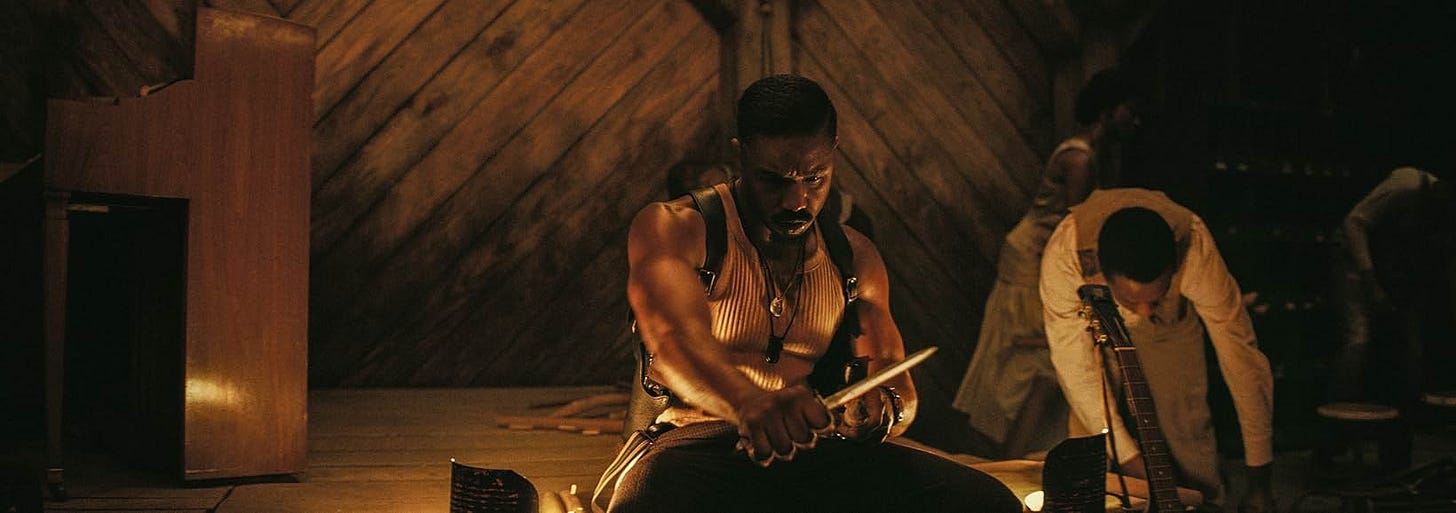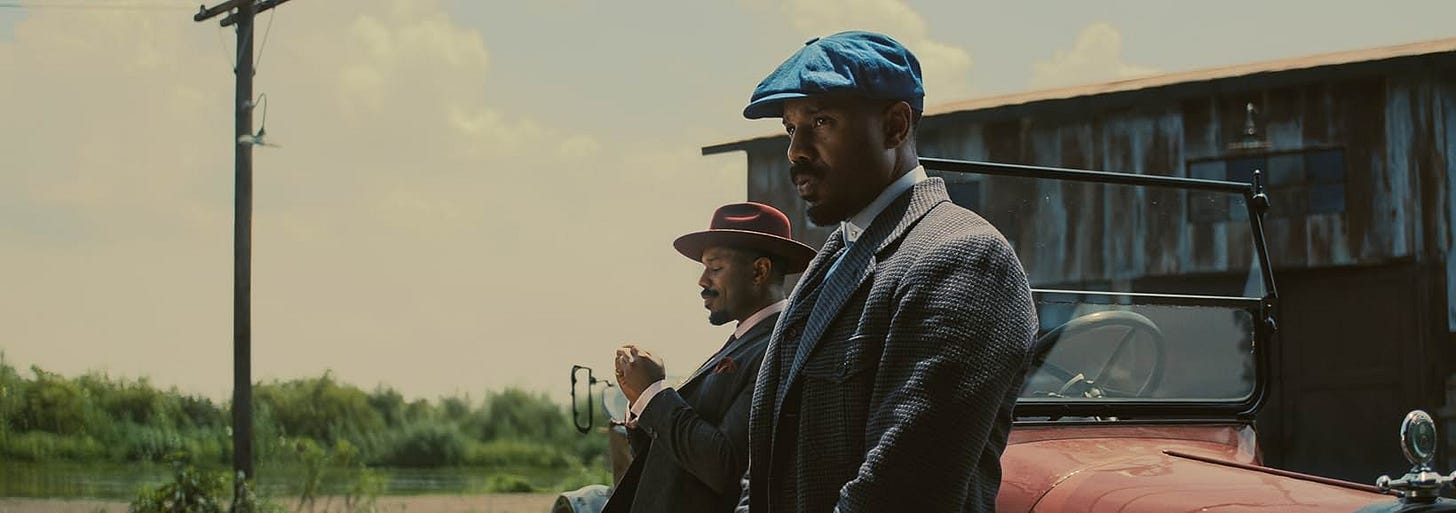Sinners: Flawed Spirits Make for a Good Time
Pouring cold water on cultural phenomenons one step at a time
Vampires. KKK. 1930s. Tommy Guns. Michael B. Jordan’s Guns. Who could say no? All in a Black-led, genre-blending, R-rated blockbuster storming the box office pre-summer. Historic stuff. While I might be fashionably late to the firestorm that Sinners has kicked up all over social media, I finally caught up—and while I get the buzz, I’ve got bones to pick. After over ten years of directing IP films, Ryan Coogler has returned to original filmmaking. Starring Coogler regular Michael B. Jordan and Hailee Steinfeld, Sinners charts the story of twin brothers who return to their hometown to discover a great evil possesses their town. Sinners sparked a massive bidding war early last year to ultimately land in the laps of Warner Bros. In a ground-breaking deal wherein Coogler gets to own the film’s rights after twenty-five years, the director is betting on himself. And with a strong box office and phenomenal word of mouth to boot, he seems to have made good on his promise. Still, is Sinners’ success the mark of a new auteur? Or is this an overpraised one-off?
What’s it all about?
Set over a day, in 1932 Mississippi, Sinners follows WWI vet twins Smoke and Stack (Michael B. Jordan) as they flee a criminal past in Chicago to open a juke joint in their racially divided hometown. With the help of their guitar prodigy cousin Sammie (Miles Caton), who’s torn between his preacher father’s warnings and the pull of the blues, they try to build a sanctuary for the Black community. But as the day unfolds, buried traumas, rekindled romances, and a growing sense of supernatural dread rise to the surface—culminating in a night where music, blood, and myth collide.
Slow burn. Still fire?
As much as I admire what Sinners represents and the cultural phenomenon it has become, it doesn’t mean it’s beyond critique. For all its ambition and cultural weight, Sinners stumbles in some key areas that keep it from truly shining. Namely, its story structure and character development. Sinners is a picture that needed another round of editing to fine-tune its pacing since, as it stands, scenes run very long without much rhyme or reason. The decision to set the story over the course of a single day ultimately undermines the film’s ability to build meaningful stakes and develop its characters thoughtfully. Our introductions aren’t very visual either, as character backstories are painstackingly revealed through long bouts of dialogue. We slog through the film’s first-half at a laborious Altman-esque pace, seeing how the twins reconnect with old friends and family to recruit them for their juke joint. Why are they so compelled to run a juke joint? And why does it have to open tonight? These are questions the film never bothers to address, which ultimately drains the story of any real urgency. None of these early encounters with the stock characters reveal anything we couldn’t have learned later. Worse, they fail to build the emotional connection needed for what follows. The vampires teased in the trailers don’t appear until the film's midpoint. So, the film’s first half is left adrift until the juke joint is set up, where the twins lack a compelling motivation or source of tension to propel them forward. With the vampires arriving late, the mob or the Klan seemingly could have supplied this early tension, but neither threat materializes with enough force to thrust the story into motion.
How do Vampires become racist?
While Sinners has been undoubtedly marketed as a theatrical blockbuster, the word original has played an integral role in Sinners’ ever-growing buzz. In Ryan Coogler’s first five films, there’s a clear through-line of fascinations and obsessions—black identity and representation, generational trauma, Black mythology and culture, along with preservation of said identity amid oppression. All of that feels present in Sinners, but the execution forces the insights to appear very surface-level and muddied. The introduction of vampirism and musical elements injects ingenuity into Coogler’s treatment of the ideas he’s fascinated with. But it’s often difficult to pinpoint what the film is trying to say at any given moment. For instance, we see a major connection between music and the soul, along with the spirit of community and culture. There’s even a brilliant oner toward the intermission of the film that’s absolutely breathtaking, which orchestrates a moment of musical fusion, connecting the ghosts of Black music history into one spectacular cinematic montage. Yet, its purpose was difficult to comprehend as Sinners attempts to also align vampirism with racial and spiritual oppression. Thus, the film’s metaphors and allusions are left quite muddy. Vampires here aren’t just oppressors, sucking the soul out of the black community—they speak of escaping white oppression and biblical lies. Many times, they were spitting facts, more or less. It’s provocative, but confusing. Is vampirism liberation or corruption? The film flirts with both ideas but doesn’t commit to either, and the KKK-vampire connection is never fully explained. It is certainly possible that there’s a deeper thematic cohesion I wasn’t able to fully grasp on first viewing. But, the film still does very little to consolidate its many ideas into a coherent whole.
Turn it up to 11
Coogler’s ambition for scale and scope clouds the clarity of his vision. I believe Sinners would have benefited from telling its story over a longer period to earn the character beats and ramp up the tension. Still, Coogler decided to stick with the one-day story, which is fine, but I don’t think it necessarily merits the same exhibition style films like recent films such as Killers of the Flower Moon or The Brutalist. Sinners wants to be an epic, but it’s more John Carpenter than David Lean. Shot on Ultra Panavision 70 along with IMAX cameras, the film boasts textured, painterly frames, especially during golden hour. While the imagery, set design, and costumes are visually rich, the wide format distances us from the characters and surroundings, and the high-contrast lighting sometimes mutes emotions when it should heighten them. Coogler’s visual ambition is undeniable, but it often clashes against the palpable dread of a true Southern Gothic tone he’s chasing. Instead of embracing the harsh, sunlit reality of the Deep South, the film often opts for shadowy, horror-inspired lighting that feels at odds with its setting. A setting that’s horrifying enough as it is. As a result, the environment never feels as naturally oppressive as it could. Yet, despite these inconsistencies, Sinners never feels like a product of studio compromise; its wild swings and gonzo flourishes suggest a filmmaker still chasing something true.
What more can you want?
While I’ve spent the majority of this review dogging on the year’s most notable film. I didn’t hate it. Far from it. Is there a better film hidden inside Sinners? Yes. But was I entertained? You betcha. It’s Erotic. Western. Sexy. Horror. Gangster. Thrilling. Musical. Funny. Bloody. What more could you want from a movie? Even if it bites off more than it can chew, it does so with flair—and fangs. For all its flaws, it’s undeniably one of the most original commercial films the studio system has produced in years. The performances are charismatic across the board, and Ludwig Göransson’s genre-hopping score—blending Southern blues and folk with blistering heavy metal—is a showstopper that elevates the film into delightful horror excess. Some of the action scenes and moments of tension could have been drawn out for more tautness (always think Brian De Palma), but Sinners does deliver on some truly nail-biting and kinetic sequences.
Sinners doesn’t fully make good on its thematic ambitions, which is a shame since I believe if Coogler committed himself to a more coherent vision, the genre-bending wouldn’t have been merely novel but something transcendent. Yet the film never takes itself seriously enough to care. It fully embraces corny tropes, like characters taking a piss in the dark with vampires lurking, just to earn that classic 'oh no you didn’t' from the crowd. But every brilliant yarn should end on a strong note, and with two post-credit scenes, Sinners does not. But it’s a film made in earnest with a strong spirit that’s far more daring than the average studio fare. Its primary goal is entertainment, and sometimes, that's exactly what you need. Watching Michael B. Jordan mow down Klansmen with a Tommy Gun is all a guy can ask for. In the age of A Minecraft Movie, Sinners provides a breath of fresh air that I hope Hollywood is keen on taking advantage of. Because audiences clearly want this.










I think maybe I have cracked your “deeper thematic cohesion” question and I wanted to see what you think.
Much like you, I was late to the party on Sinners and, much like you, I left the theater impressed by the film, but confused and somewhat unsettled by the vampires and what they represented. I looked to the critics for an answer, but no one seemed to know. Did they represent cultural appropriation? Systemic oppression? Colonization? Exploitation? Assimilation? General whiteness? Some of these things? All of these things? It appeared, as you said, all “surface level and muddied”.
But I sensed there was something there. Maybe you sensed it too. The vampires were like a riddle. What is an atheistic group that is both liberating and oppressive, where all the members dance in step but the leader calls the tune? It drove me crazy for a few days, until it finally came to me. These sympathetic, anti-racist vampires don’t represent bloodsucking capitalists, or mainstream assimilation, or even white society trying to piss in the punchbowl, they are what they clearly say they are — internationalist collectivist radicals. Communists! Joining with them you lose your soul because you lose your culture and individuality. That’s why the vampire shows up in in 1932 during the Great Depression when left-wing politics had its greatest mass appeal (also when left-wing ethnomusicologists were literally collecting black folk songs as well as some black artists — Lead Belly comes to mind), and then the film flashes forward to vampire Stack’s visit in 1992 right after the worldwide collapse of communism.
In this political allegory, African American economic independence (“for us, by us”)— which is discussed throughout the first act and has been noted as minor thematic component by many critics — is actually the overarching theme. Specifically how this independence was under siege in the 20th century from both sides of the political spectrum. The entrenched right-wing establishment (represented by the Klan) used force to control and economically exploit the black artists and entrepreneurs (to quite literally rob and emasculate them like in Delta Slim’s story and the twins in the sawmill deal) whereas, the left-wing political insurgents tried to seduce the black artists with talk of common enemies, promises of equality, and alluring folk melodies, in order to use their culture to help realize their own revolutionary political goals. The far right wanted to rob them and the far left wanted to “turn” them. The left gets Stack, the right gets Smoke, and Sammy escapes both, and the church as well, by choosing to follow his creativity and be a Sinner, and then goes on to make his own way and achieve the Twin’s dream of owning a club where we see a white bartender working for him. He achieved his own success relying on his culture and his creative power, not some external paternalistic force like the Communist Party or the Church.
Why didn’t I make this connection earlier? The vampires are essentially spouting communist propaganda throughout the entire second half of the film. I think it’s because liberal audiences (myself included) have a blindspot for this interpretation. Our expectations have been subverted. It’s too reactionary. No one wants to think of Pete Seeger singing “Kumbaya” as a culture-sucking vampire. But it’s actually kinda brilliant. I also think there is a deliberate muddling of themes on Ryan Coogler's part. I am not sure he wants the critics at the NYT and the Guardian to know exactly what he's getting at.
So in the end, while it’s not a perfect movie, I think when viewed through this allegorical lens everything more or less falls into place and the film is as good or better than the liberal critics pretend to think it is.
Sorry for using your substack to pitch this theory. It might be wrong, but I had to get it out of my head. I'd love to hear if you find it at all persuasive.
You are right, and I'd go further. In a post-Get Out, post-Black Panther (I see the irony) world, a movie should be asked to surpass the "Black take on genre film" bar for us to consider it good, no? First make it make sense, no? Maybe the reason no one can put a finger on what this movie is about is because the movie doesn't know what it's about.
I'm loving these "you're dumb because you think this movie is muddled" responses. Because they all point to a theme that doesn't make sense if you think about the film for more than five seconds. Vampirism as colonial assimilation? But then what about the last scene where two of them are suddenly still alive and happy to leave Sammie alone thanks to a deal made with Smoke? Are they assimilated? And then why is Sammie's preacher-man father not "assimilated" into vampirism? If you want religion to be seen as a tool of colonial oppression, show it as such. (Also, watch Midnight Mass). Vampirism as Communism??? They literally gain the power to devour through the exchange of gold (or do they? See Cornbread's unexplained death)! And yet, I see why you could get confused enough to think it's about Communism, because the film is literally confused. We're asked too many times to count for an answer to the meaning behind the vampirism in this movie which ends up being the reason why there is no answer. It's a million arrows pointing nowhere.